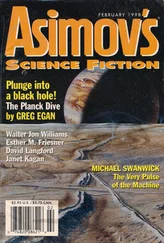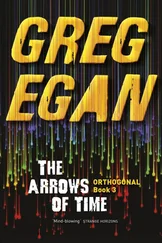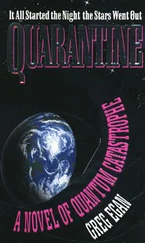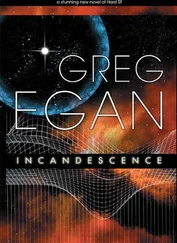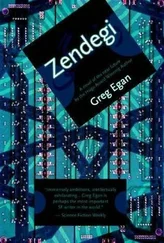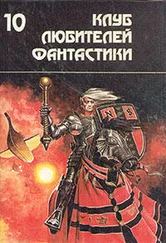Greg Egan - The Eternal Flame
Здесь есть возможность читать онлайн «Greg Egan - The Eternal Flame» весь текст электронной книги совершенно бесплатно (целиком полную версию без сокращений). В некоторых случаях можно слушать аудио, скачать через торрент в формате fb2 и присутствует краткое содержание. Жанр: Фантастика и фэнтези, на английском языке. Описание произведения, (предисловие) а так же отзывы посетителей доступны на портале библиотеки ЛибКат.
- Название:The Eternal Flame
- Автор:
- Жанр:
- Год:неизвестен
- ISBN:нет данных
- Рейтинг книги:4 / 5. Голосов: 1
-
Избранное:Добавить в избранное
- Отзывы:
-
Ваша оценка:
- 80
- 1
- 2
- 3
- 4
- 5
The Eternal Flame: краткое содержание, описание и аннотация
Предлагаем к чтению аннотацию, описание, краткое содержание или предисловие (зависит от того, что написал сам автор книги «The Eternal Flame»). Если вы не нашли необходимую информацию о книге — напишите в комментариях, мы постараемся отыскать её.
The Eternal Flame — читать онлайн бесплатно полную книгу (весь текст) целиком
Ниже представлен текст книги, разбитый по страницам. Система сохранения места последней прочитанной страницы, позволяет с удобством читать онлайн бесплатно книгу «The Eternal Flame», без необходимости каждый раз заново искать на чём Вы остановились. Поставьте закладку, и сможете в любой момент перейти на страницу, на которой закончили чтение.
Интервал:
Закладка:
It would be easy enough. She could make it quick. She would mourn and wail afterward, for sure, but the satisfaction of the act itself would be incomparable. Can you understand my stubbornness, now? Can you finally see the downside of having your brain split in two?
She kept the glorious vision spinning in her head, promising herself the giddy dance of retribution even as she forced her grip to weaken. Tamaro broke free and crawled across the ground, spitting up traces of loose food. Then he rose to his feet and jogged away down the path.
Tamara closed her eyes. If she’d had no other hope, she might have done anything. But Erminio’s lies would catch up with him, and someone would come looking for her.
18
Carla waited quietly at the entrance to Assunto’s office until he looked up from his work and gestured for her to enter. “There’s good news and there’s bad news,” she announced as she dragged herself toward his desk. “But best of all, there’s a chance to make the bad news good.”
Assunto managed a weary buzz. “Why can’t things ever be simple with you?”
“I make them as simple as possible,” Carla replied. “But no simpler.”
“So tell me the good news.”
Carla took a sheet of paper from her pocket and handed it to him.
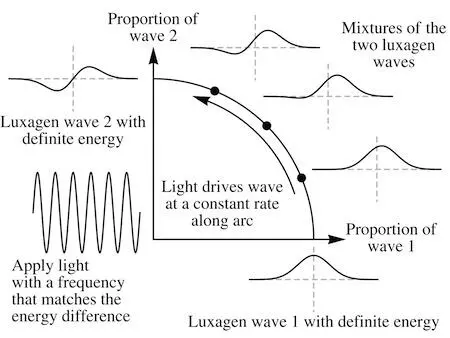
“This is what happens when you take a luxagen with access to just two energy levels and hit it with a beam of light at a frequency tuned to the difference between those levels.”
Assunto stopped her. “What does that mean? ‘Tuned to the difference’?”
“Ah.” Carla realized that it had become second nature to her to think of energies and frequencies as interchangeable. She had to make a conscious effort now to unpack the details behind the instinctive translation. “If you imagine a particle and a wave moving at the same speed, the energy of the particle will be proportional to the frequency of the wave—with the ratio unchanged as you vary their common speed. If you set the speed to zero, the ratio is the mass of the particle divided by the maximum frequency of the wave—and that’s what it remains for every other speed.”
“That’s just geometry!” Assunto said. “The wave’s propagation vector will be parallel to the particle’s energy-momentum vector. That locks all of their components into a fixed ratio with each other.”
Carla said, “Yes—but now go a step further and suppose that the same ratio holds for every wave and its corresponding particle, whether it’s a luxagen wave and a luxagen or a light wave and a photon. None of the physics makes sense unless this ratio is a universal constant; I think of it as ‘Patrizia’s constant’, because the whole idea started with her. It’s as if these particle masses really are the maximum frequencies of the corresponding waves… just measured in different units.”
Assunto looked pained for a moment, but then he said, “You mean like times and distances?”
“Perhaps.” Carla didn’t want to over-reach with the comparison: one was a fundamental truth about the cosmos that the Peerless itself had helped to prove beyond doubt; the other was an appealing, but still untested, speculation.
Assunto said, “So let’s take it for granted that we can turn any frequency into an energy, and vice versa. You have a luxagen trapped in some energy valley, and the corresponding wave equation has two solutions with definite frequencies.”
“Yes,” Carla replied. “What I’ve drawn for the two waves is their variation in space, but while maintaining that shape they’re oscillating in time, each one with its own pure frequency.”
“Then you add a light wave whose frequency matches the difference between the luxagen frequencies—and it drives the low-frequency luxagen wave up to the higher frequency?”
“Yes.”
“Well, that much makes sense,” Assunto said. “You can do something similar with waves on a string, if you vary the tension periodically at a frequency equal to the difference between the frequencies of two resonant modes.”
“What’s more surprising, though,” Carla said, “is the simple rule that this wave follows along the way. Where I’ve plotted the proportion of each of the waves, the arc that links the point that’s ‘purely wave one’ to the point that’s ‘purely wave two’ isn’t an artistic flourish: the dynamics really does follow a perfect circular arc. The sum of the squares of the two proportions remains equal to one, throughout the process.”
“I see.” Assunto was prepared to take her word for this, even if the significance of it escaped him.
Carla said, “Hold on to that thought.”
She produced the second sheet.

“I take it that this is the bad news.” Assunto examined the diagram. “The light never frees the luxagen? So… that’s the end of your theory of tarnishing?”
“Wait!” Carla pleaded. “When there are just two waves, two energy levels, you’d expect the dynamics to take you all the way from one pure wave to the other. Where else are you going to go? But here, there are a multitude of free waves whose frequencies are almost identical—what I’m showing on the vertical axis covers them all. So there are ways you can wander around in this space of possibilities—keeping the sum of the squares of the proportions equal to one, as before—without the trapped-wave proportion ever falling to zero.”
“Without it ever falling very far at all,” Assunto noted, pointing to the modest arc that showed the limits of the process. “Which I can well believe, given your assumptions. But why isn’t it fatal? How can this be a description of light knocking a luxagen out of its valley, if the wave barely changes no matter how long you expose it to the light?”
Carla braced herself. She had managed to convince Patrizia and Onesto that her hypothesis wasn’t entirely deranged, but Assunto would be the real test.
“The thing is,” she said, “there’s always more than one luxagen and a light wave to consider. There’s the whole slab of mirrorstone as well. We can sum up most of its influence in terms of a simple ‘energy valley’, but the reality is more complicated than that. With all the luxagen waves reaching part-way out of their own valleys, every luxagen is interacting with its neighbors—and to some degree with its neighbors’ neighbors, and so on.”
“So your model’s inadequate?” Assunto suggested.
“Yes,” Carla conceded. “But a model of the entire solid would just be intractable. The only way we can get anywhere is to try to find a rule of thumb that lets us extract useful predictions from the things we can model.”
Assunto was skeptical. “What kind of rule?”
“We start with two reasonable assumptions,” Carla said. “If a wave that is purely trapped interacts with the rest of the solid, it remains trapped. If a wave that is purely free interacts with the rest of the solid, it stays free.”
Assunto said, “I can live with that. But what happens to a mixture of the two?”
“I doubt we could ever predict that with certainty,” Carla admitted. “Not without knowing exactly what’s going on with every single luxagen in the solid. But maybe we can still predict what will happen on average . If we treat the square of the proportion of the wave that’s trapped as the probability that the luxagen will remain trapped when it interacts with the rest of the solid, everything makes sense—because the squared proportions always add up to one, just as the probabilities for any set of alternatives always add up to one. I know it sounds too simple to be true—but the mathematics seems to be offering us the perfect number to use as a probability when we can’t make an exact prediction.”
Читать дальшеИнтервал:
Закладка:
Похожие книги на «The Eternal Flame»
Представляем Вашему вниманию похожие книги на «The Eternal Flame» списком для выбора. Мы отобрали схожую по названию и смыслу литературу в надежде предоставить читателям больше вариантов отыскать новые, интересные, ещё непрочитанные произведения.
Обсуждение, отзывы о книге «The Eternal Flame» и просто собственные мнения читателей. Оставьте ваши комментарии, напишите, что Вы думаете о произведении, его смысле или главных героях. Укажите что конкретно понравилось, а что нет, и почему Вы так считаете.

